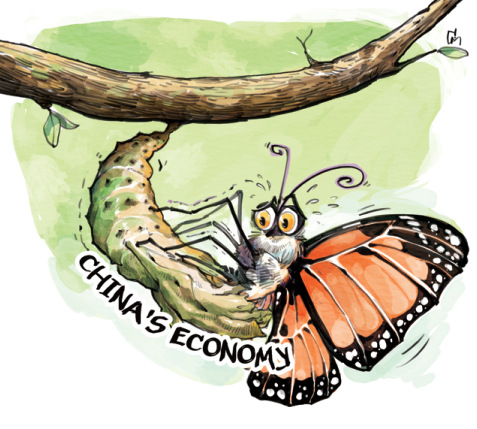
CAI MENG/CHINA DAILY
For more than a year, headlines worldwide have been pointing to a Chinese economic slowdown. But a closer look at regional dynamics within China tells a different story-one that is less about deceleration than changing gears.
According to China's National Bureau of Statistics, the resource-rich province of Shanxi in North China has suffered an economic slowdown, but Southwest China's Chongqing municipality and Guizhou province have experienced vibrant growth. North China's Hebei province and three other northeastern provinces are feeling the effects of recession, but the heavy-industry economies of Tianjin municipality, and North China's Shandong province and East China's Jiangsu province are booming.
After the 2008 financial crisis, when slower growth became the "new normal" for many countries, China began accelerating its economic rebalancing by shifting the drivers of growth from manufacturing and exports toward goods and services for domestic consumption.
This transition has had far-reaching implications for the future dynamics of China's economy. Previously, the economic activities that are now flourishing weren't categorized as manufacturing industries at all, but as "services". But services do not exist in a vacuum. All businesses need manufactured products, transportation, information and communications technology (ICT), logistics, real estate, finance, insurance and more.
Thus, new demand for new services has virtuous-cycle effects in terms of capital investment in infrastructure and equipment. Contrary to the conventional wisdom, the growth of services in China to meet domestic demand does not mean the end of manufacturing and capital investment, much less of economic growth.
Service sectors stand to make up for much, if not all, of the growth lost to lower output in export-oriented manufacturing sectors. China's transportation, ICT, finance, insurance, real estate, education and healthcare sectors have long had inappropriately low labor productivity, which means they have significant room to grow faster.
According to a paper by economists Jong-Wha Lee and Warwick J. McKibbin, service-sector productivity growth in Asia "benefits all sectors eventually, and contributes to the sustained and balanced growth of Asian economies". Examining economic development trends in the Republic of Korea, the authors find that the average value added per worker in transportation, real estate and ICT is now higher than the average in manufacturing, and they point to similar dynamics in the United States, Japan and China.
This finding suggests that rapid development in China's service economy could reverse the externally triggered dampening of growth since 2008. But, as the Japanese and ROK transitions from export to domestic demand-driven growth demonstrate, structural transformation is a slow and painful process.
China is in the midst of that process, and it must be careful not to undermine existing sources of growth lest it fall into a structural trap where the cost of transition itself derails new gains. It is not a good sign that the high costs in many Chinese provinces have been weighing down overall growth.
This points to fundamental challenges ahead, notwithstanding the significant economic potential of Chinese consumers. For starters, economic development based on diversified domestic demand is more complicated than export-driven development, because these new sectors rely more heavily on sophisticated financial services, free and equitable market access, better educated workers, and higher investment in research and development.
As a result, the new businesses emerging from the shift to a new growth model are demanding far more from China's current economic-governance system than it can bear. Further structural reforms would go a long way toward fixing this problem, but they will also require China's leaders to make tough political decisions that won't please everyone.
Another fundamental challenge is China's slow rate of urbanization, which is still lagging, even after 25 years of export-led growth. Each of a thriving service economy's major components-ICT, finance, insurance, transportation and real estate-needs the others to prosper, and cities are what bring them all together-a phenomenon of network externalities.
China's cities will be a key ingredient of its long-term economic success. Urbanization should start accelerating today, and over the next 10-15 years, with the expansion of metropolitan areas geared toward the needs of services-led economic growth. If China can rise to that challenge, it will be well positioned to clear the remaining hurdles in its path toward high-income status.
The author Zhang Jun is a professor of economics and director of the China Center for Economic Studies at Fudan University.


















































